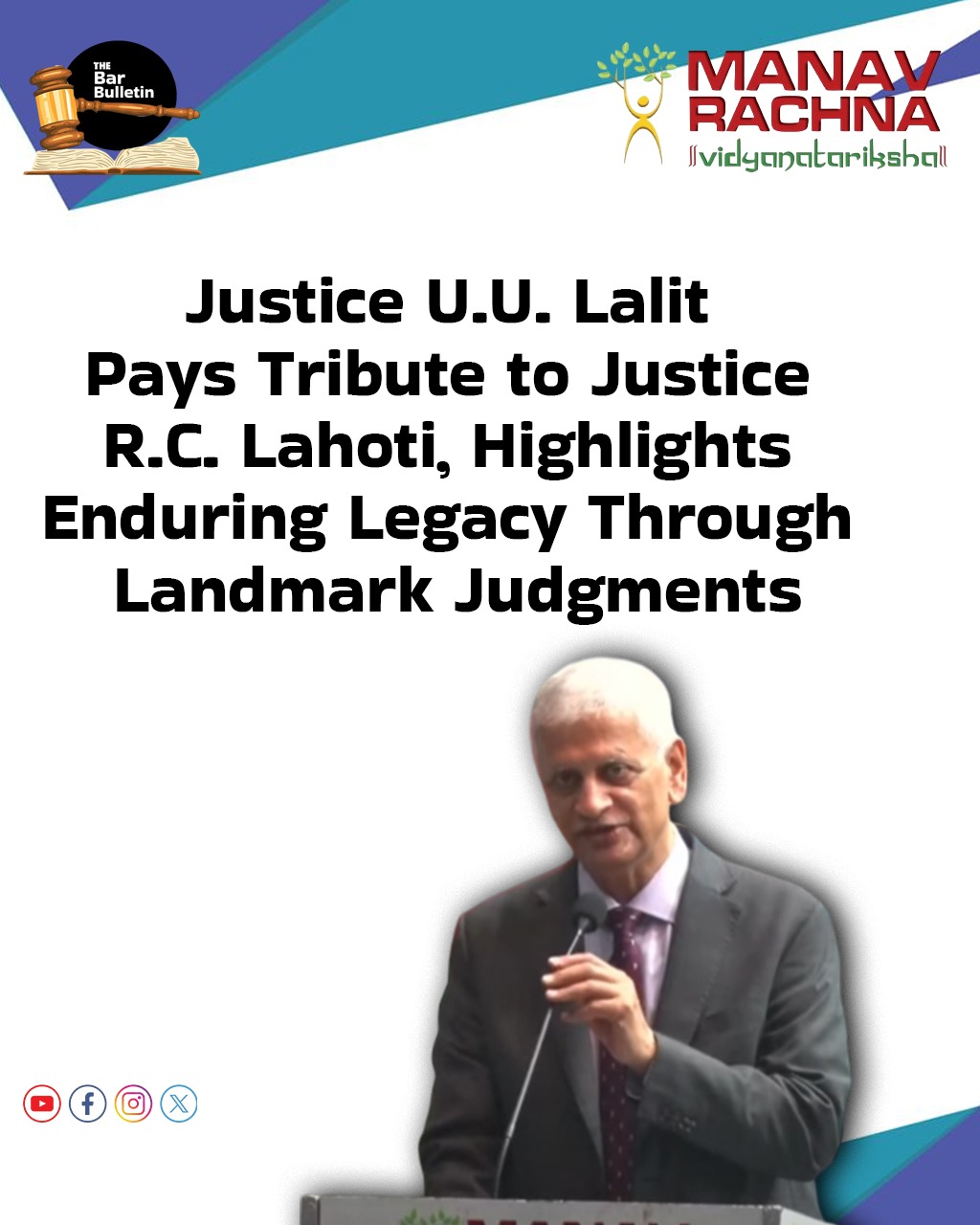At the 2nd Justice R.C. Lahoti Memorial Lecture organised by Manav Rachna, Hon’ble Justice U.U. Lalit, Former Chief Justice of India, delivered a heartfelt tribute to the late Justice Lahoti, reflecting on his judicial philosophy, legacy, and landmark decisions that continue to shape Indian constitutional law.
Justice Lalit began by expressing his humility and slight nervousness in speaking at an event honouring such a towering figure in Indian jurisprudence. “These are large shoes to fill,” he remarked, describing Justice Lahoti as a true karma yogi on the Bench meticulous in preparation, attentive during arguments, clear in reasoning, and concise yet impactful in his judgments.
Recounting his own early years as a senior counsel, Justice Lalit noted how frequently he appeared before Justice Lahoti and closely observed his courtroom conduct and judicial style. He described Justice Lahoti’s presence as calm yet commanding, and his decision-making as deeply rooted in principle and constitutional discipline.
Justice Lalit then discussed three landmark judgments to illustrate the depth and foresight of Justice Lahoti’s jurisprudence each one personally significant as he had appeared in these matters as counsel.
Justice Lalit referred to P.A. Inamdar as one of Justice Lahoti’s most significant and enduring constitutional decisions. Delivered by a seven-judge Bench led by Justice Lahoti, the judgment responded to the confusion created by the earlier rulings in T.M.A. Pai Foundation and Islamic Academy. Justice Lahoti’s opinion brought clarity to the rights of unaided educational institutions and addressed the question of whether the State could enforce reservation in such institutions.
The Bench held that in unaided institutions whether minority or non-minority there was no constitutional basis for enforcing reservation, as the State’s involvement was absent. Justice Lahit’s reasoning reinforced institutional autonomy while maintaining constitutional fidelity.
Justice Lalit highlighted a particularly powerful paragraph from the judgment, where Justice Lahoti acknowledged that while the judiciary cannot legislate, it may step in where there is a legislative vacuum, subject to the power of Parliament to intervene. That balance between restraint and responsibility, he noted, is a hallmark of judicial statesmanship.
He also remarked that although Parliament subsequently enacted the 93rd Constitutional Amendment to counter some aspects of Inamdar, the judgment remains a guiding precedent to this day.
Justice Lalit next turned to the Bal Patil case, which dealt with the question of whether the Jain community could be declared a minority at the national level. Justice Lahoti presided over the Bench, though the opinion was authored by Justice D.M. Dharmadhikari.
In his reflections, Justice Lalit emphasized the caution exercised by Justice Lahoti in dealing with sensitive issues of identity. He recalled the deliberations during the hearings, noting how Justice Lahoti repeatedly stressed that recognizing every community as a separate minority could sow distrust and potentially fragment national unity.
Justice Lahoti, he said, believed that such declarations must be viewed not just legally but through the lens of social harmony and historical experience, including the impact of religious divisions during the partition. The judgment ultimately rejected the plea, underscoring the importance of cohesion over compartmentalization.
Finally, Justice Lalit discussed the Sarbananda Sonowal case, where the Supreme Court struck down the Illegal Migrants (Determination by Tribunals) Act, 1983, on the ground that it failed to adequately address illegal immigration in Assam.
Justice Lahoti’s Bench viewed the uncontrolled influx of illegal migrants as a form of aggression one that could cause internal disturbance and undermine national integrity. Justice Lalit noted that the judgment, anchored in Article 355 of the Constitution, recognized the responsibility of the Union to protect states against such threats.
He described the ruling as a strong reaffirmation of constitutional duty, national security, and the preservation of demographic balance issues that remain relevant to this day.
In closing, Justice Lalit said he chose to highlight these three decisions because they each represented a different facet of Justice Lahoti’s jurisprudence: clarity in constitutional law (Inamdar), sensitivity in social identity questions (Bal Patil), and firmness in national security and governance (Sarbananda Sonowal).

